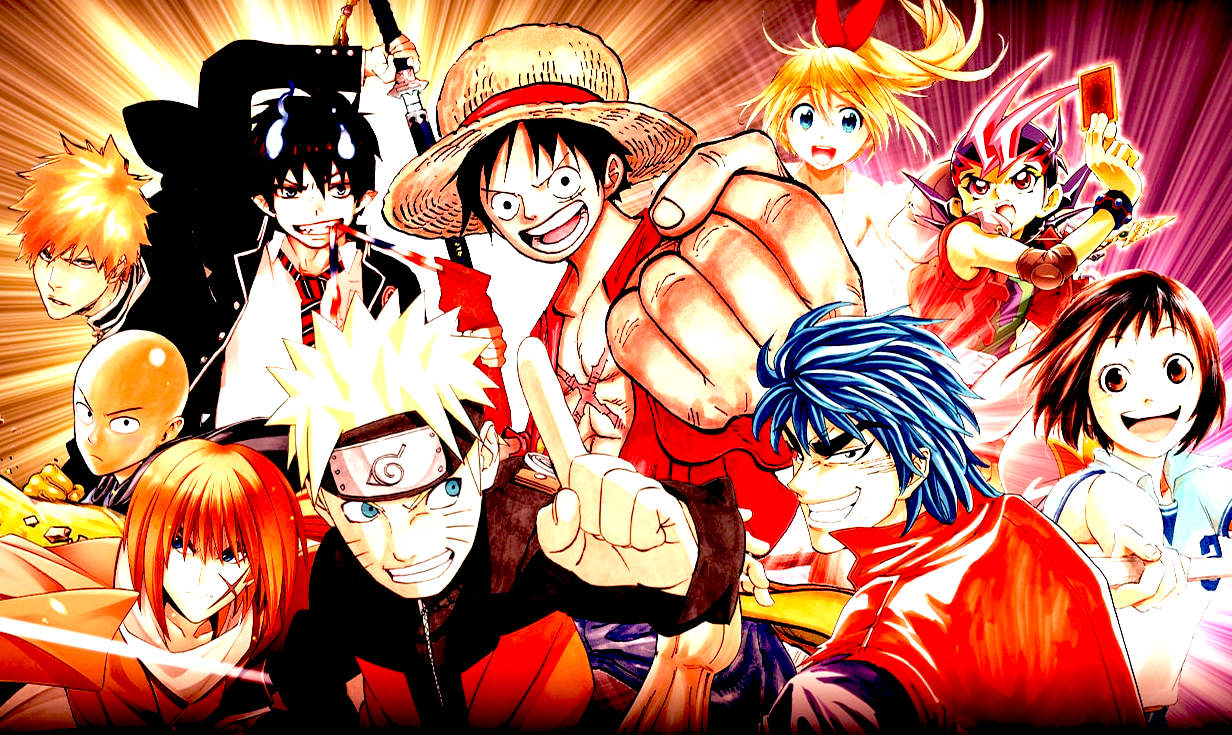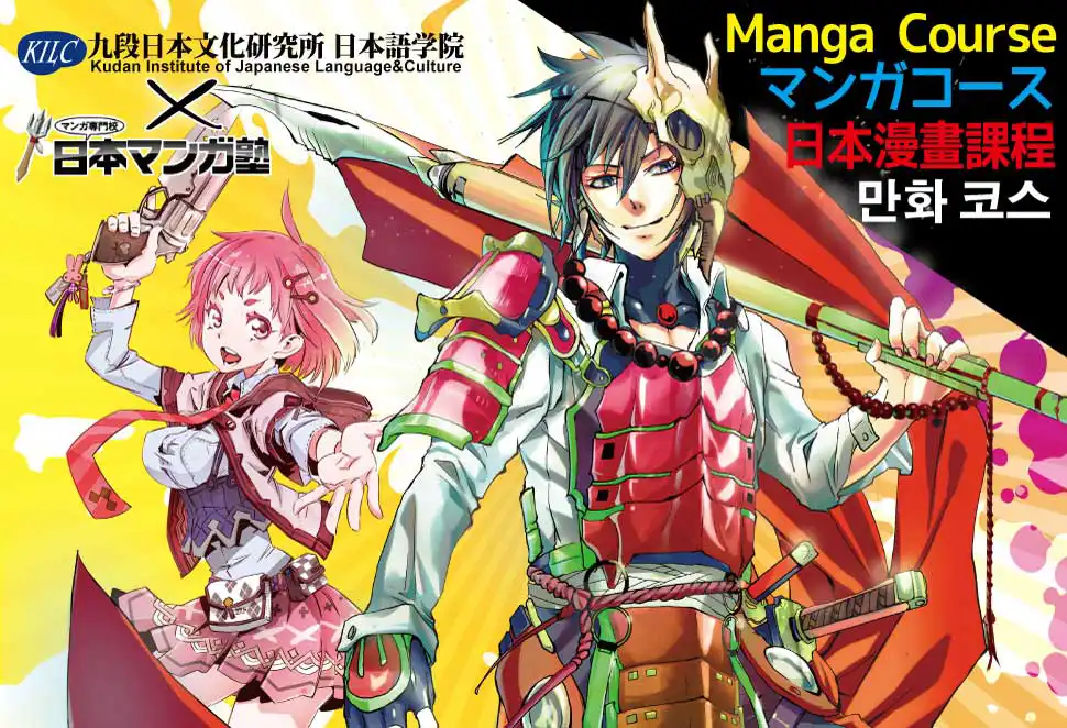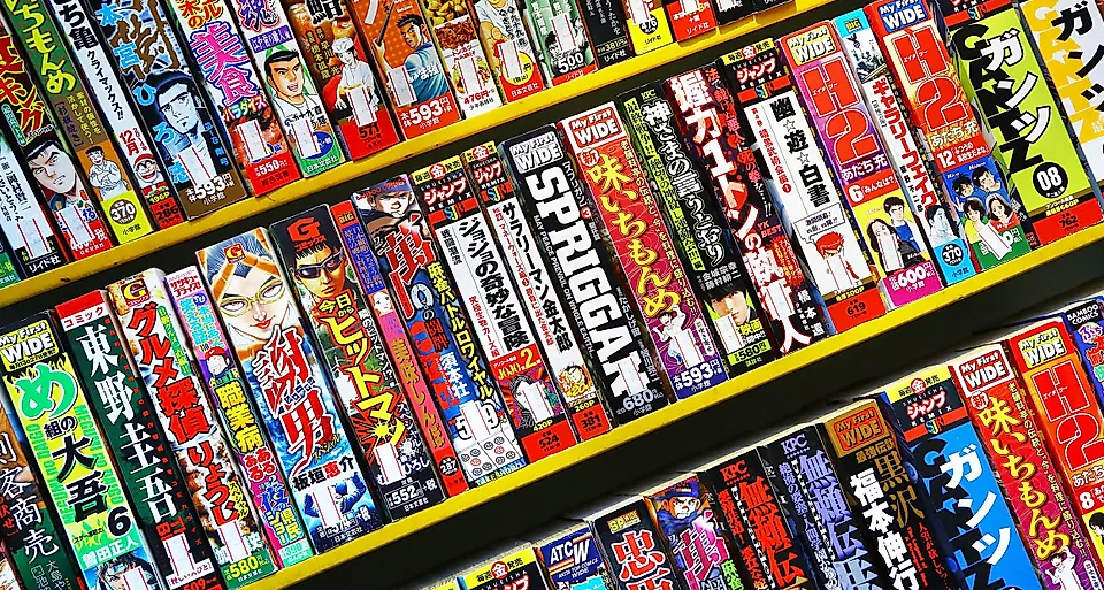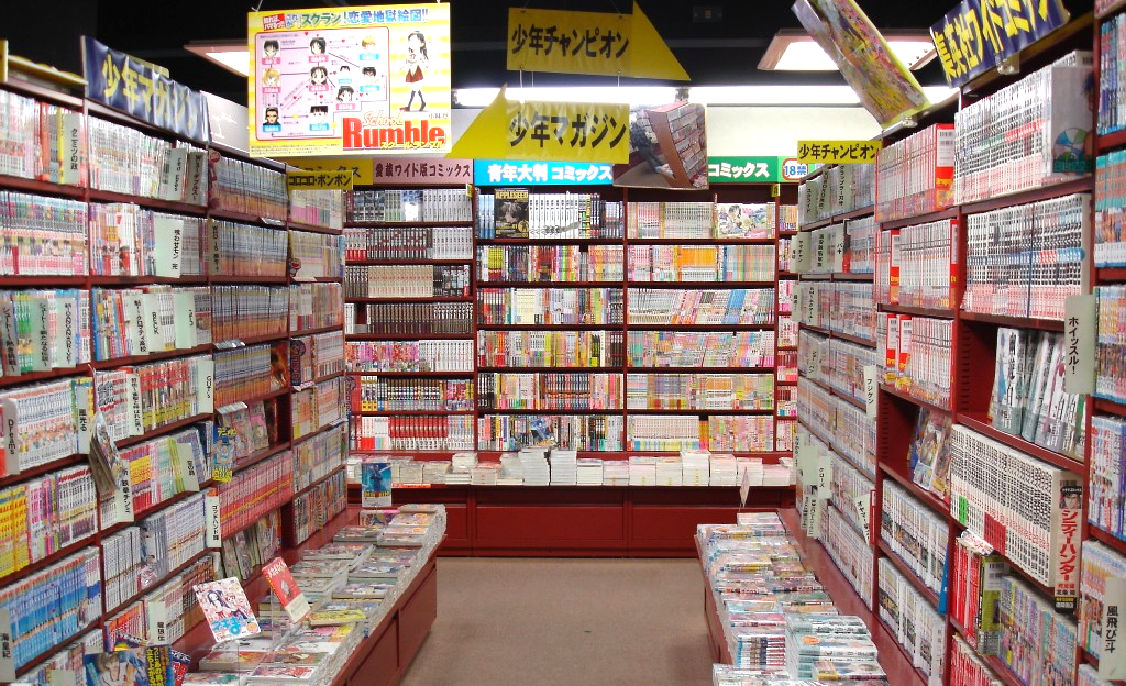|

Manga are comic books created in Japan using their specific style of drawing characters. Everyone in japan reads manga; it is a very popular art form that features every genre one can imagine. Their popularity in the west has been growing for the past few decades. Manga should not be confused with anime, which are Japanese animated shows and movies. However, many anime (animated shows from Japan) are adapted from a manga source.
The manga industry is huge, with certain series rivaling even the comic book titans such as
Spiderman in sales. Artists in other parts of the world are greatly inspired by manga. Some countries even have comic books that are so under the influence of mangas that they make up their own category. Some examples are “manhwas” in South Korea and “manhuas” in China.
Manga shares its art style with anime, the characters have large eyes and large spiky haircuts, that helps to distinguish them better. Manga is published in black and white, as opposed to western comic books that are mostly in color. The main reason for this is because mangas are drawn by a single person and are published weekly. Coloring them would take up too much time. Manga chapters are published in various weekly magazines and are later collected in volumes.
There is a large number of genres present in the manga world, almost every single one you can imagine. That is why their target audience mostly classifies them. There are five large groups in total. We can start with shounen and shoujo. Shounen manga is for boys and is often action-packed and adventurous with some comedic elements. Shoujo manga is aimed at girls often involves romance and everyday life, although it does not shy from action and adventure as well. Seinen manga is aimed at men and deals with adult themes, drama, violence, and even sexually explicit material. Josei is written for women and deals with more mature themes than shoujo manga. It often deals with relationships but from the view of an adult. Finally, kodomo is manga for little children.
Manga (Japanese:
漫画 [maŋga]) are comics or graphic novels originating from Japan. Most manga conform to a style developed in Japan in the late 19th century, and the form has a long history in earlier Japanese art. The term manga is used in Japan to refer to both comics and cartooning. Outside of Japan, the word is typically used to refer to comics originally published in the country.
In Japan, people of all ages and walks of life read manga. The medium includes works in a broad range of genres: action, adventure, business and commerce, comedy, detective, drama, historical, horror, mystery, romance, science fiction and fantasy, erotica (hentai and ecchi), sports and games, and suspense, among others. Many manga are translated into other languages.
Since the 1950s, manga has become an increasingly major part of the Japanese publishing industry. By 1995, the manga market in Japan was valued at ¥586.4 billion ($6–7 billion), with annual sales of 1.9 billion manga books and manga magazines in Japan (equivalent to 15 issues per person). In 2020 Japan's manga market value hit a new record of ¥612.6 billion due to the fast growth of digital manga sales as well as increase of print sales. Manga have also gained a significant worldwide audience. Beginning with the late 2010s manga started massively outselling American comics. In 2020 the North American manga market was valued at almost $250 million. According to NPD BookScan manga made up 76% of overall comics and graphic novel sales in the US in 2021. The fast growth of the North American manga market has been attributed to manga's wide availability on digital reading apps, book retailer chains such as Barnes & Noble and online retailers such as Amazon as well as the increased streaming of anime. According to Jean-Marie Bouissou, manga represented 38% of the French comics market in 2005. This is equivalent to approximately 3 times that of the United States and was valued at about €460 million ($640 million). In Europe and the Middle East, the market was valued at $250 million in 2012.
Manga stories are typically printed in black-and-white - due to time constraints, artistic reasons (as coloring could lessen the impact of the artwork) and to keep printing costs
low - although some full-color manga exist (e.g., Colorful). In Japan, manga are usually serialized in large manga magazines, often containing many stories, each presented in a single episode to be continued in the next issue. Collected chapters are usually republished in tankōbon volumes, frequently but not exclusively paperback books. A manga artist (mangaka in Japanese) typically works with a few assistants in a small studio and is associated with a creative editor from a commercial publishing company. If a manga series is popular enough, it may be animated after or during its run. Sometimes, manga are based on previous live-action or animated films.
Manga-influenced comics, among original works, exist in other parts of the world, particularly in those places that speak Chinese ("manhua"), Korean ("manhwa"), English ("OEL manga"), and French ("manfra"), as well as in the nation of Algeria ("DZ-manga").

The dream course of Japanese language and Manga is now here through the collaboration of Kudan and Mangajuku!(Professional Manga School) You can learn both Japanese and Manga during your short stay of 3 months in Japan.
This course is completely original and is a special course made for those interested in Japanese manga, but is only for students of Kudan Institute of Japanese Language and Culture.
In this course, a professional manga artist together with a bilingual coordinator will assist you according to your level, and whether you are someone who likes reading manga but is a complete beginner in drawing, or for those who are experts at drawing but would like to broaden their expertise, you can be assured that students of any level can take the course.
We have already produced more than 100 student graduates from 37 different countries. While studying Japanese language, you learn how to draw manga characters, and you would be able to create an original character of your own. At the end of this course, along with the Certificate of Completion, you will also receive your works and a manga sketching textbook.
DOMESTIC MARKET
In Japan, manga constituted an annual 40.6 billion yen (approximately US$395 million) publication-industry by 2007. In 2006 sales of manga books made up for about 27% of total book-sales, and sale of manga magazines, for 20% of total magazine-sales. The manga industry has expanded worldwide, where distribution companies license and reprint manga into their native languages.
Marketeers primarily classify manga by the age and gender of the target readership. In particular, books and magazines sold to boys (shōnen) and girls (shōjo) have distinctive cover-art, and most bookstores place them on different shelves. Due to cross-readership, consumer response is not limited by demographics. For example, male readers may subscribe to a series intended for female readers, and so on. Japan has manga cafés, or manga kissa (kissa is an abbreviation of kissaten). At a manga kissa, people drink coffee, read manga and sometimes stay overnight.
The Kyoto International Manga Museum maintains a very large website listing manga published in Japanese.
LIST
OF TOP MANGA TITLES:
Fullmetal Alchemist
Bleach
Berserk
Vinland saga
Jojo's Bizarre Adventure
One Piece
Hunter X Hunter
Noragami
Yu Yu Hakusho
Vagabond
Banana Fish
Slam Dunk
NANA
One Punch Man
Naruto
INTERNATIONAL MARKETS
Traditionally, manga stories flow from top to bottom and from right to left. Some publishers of translated manga keep to this original format. Other publishers mirror the pages horizontally before printing the translation, changing the reading direction to a more "Western" left to right, so as not to confuse foreign readers or traditional comics-consumers. This practice is known as "flipping". For the most part, criticism suggests that flipping goes against the original intentions of the creator (for example, if a person wears a shirt that reads "MAY" on it, and gets flipped, then the word is altered to "YAM"), who may be ignorant of how awkward it is to read comics when the eyes must flow through the pages and text in opposite directions, resulting in an experience that's quite distinct from reading something that flows homogeneously.
If the translation is not adapted to the flipped artwork carefully enough it is also possible for the text to go against the picture, such as a person referring to something on their left in the text while pointing to their right in the graphic. Characters shown writing with their right hands, the majority of them, would become left-handed when a series is flipped. Flipping may also cause oddities with familiar asymmetrical objects or layouts, such as a car being depicted with the gas pedal on the left and the brake on the right, or a shirt with the buttons on the wrong side, however these issues are minor when compared to the unnatural reading flow, and some of them could be solved with an adaptation work that goes beyond just translation and blind flipping.

According to data form the past few years,
(as presented by Luc Bourcier, Izneo), comic books represent a worldwide market of some 6 billion
EUR, with 4 major territories involved and a growing digital dimension, especially outside of Europe. Japan is the largest comics market in the world: worth 2.6 billion EUR (43% of the global market), its revenues are 55% from digital; South Korea has a market of 662 million EUR (11%), with half of the revenues from digital (back in 2015); in the US, the market is worth 927 million EUR (15%), with a digital share of 8.7%; France comes in fourth with 550 million € of sales (8%), of which 3% digital; the rest of the world completes the picture with 1.342 billion EUR of sales.
EUROPE
Manga has influenced European cartooning in a way that is somewhat different from in the U.S. Broadcast anime in France and Italy opened the European market to manga during the 1970s. French art has borrowed from Japan since the 19th century (Japonism) and has its own highly developed tradition of bande dessinée
cartooning. In France, beginning in the mid-1990s, manga has proven very popular to a wide readership, accounting for about one-third of comics sales in France since 2004. By mid-2021, 75 percent of the €300 value of Culture Pass [fr] accounts given to French 18 year-olds was spent on manga.
According to the Japan External Trade Organization, sales of manga reached $212.6 million within France and Germany alone in 2006. France represents about 50% of the European market and is the second worldwide market, behind Japan. In 2013, there were 41 publishers of manga in France and, together with other Asian comics, manga represented around 40% of new comics releases in the country, surpassing Franco-Belgian comics for the first time. European publishers marketing manga translated into French include Asuka, Casterman, Glénat, Kana, and Pika Édition, among others. European publishers also translate manga into Dutch, German, Italian, and other languages. In 2007, about 70% of all comics sold in Germany were manga.
Manga publishers based in the United Kingdom include Gollancz and Titan
Books. Manga publishers from the United States have a strong marketing presence in the United Kingdom: for example, the Tanoshimi line from Random House. In 2019 The British Museum held a mass exhibition dedicated to manga.
UNITED STATES
Manga made their way only gradually into U.S. markets, first in association with anime and then independently. Some U.S. fans became aware of manga in the 1970s and early 1980s. However, anime was initially more accessible than manga to U.S. fans, many of whom were college-age young people who found it easier to obtain, subtitle, and exhibit video tapes of anime than translate, reproduce, and distribute tankōbon-style manga books. One of the first manga translated into English and marketed in the U.S. was Keiji Nakazawa's Barefoot Gen, an autobiographical story of the atomic bombing of Hiroshima issued by Leonard Rifas and Educomics (1980–1982). More manga were translated between the mid-1980s and 1990s, including Golgo 13 in 1986, Lone Wolf and Cub from First Comics in 1987, and Kamui, Area 88, and Mai the Psychic Girl, also in 1987 and all from Viz Media-Eclipse Comics. Others soon followed, including Akira from Marvel Comics' Epic Comics imprint, Nausicaä of the Valley of the Wind from Viz Media, and Appleseed from Eclipse Comics in 1988, and later Iczer-1 (Antarctic Press, 1994) and Ippongi Bang's F-111 Bandit (Antarctic Press, 1995).
In the 1980s to the mid-1990s, Japanese animation, like Akira, Dragon Ball, Neon Genesis Evangelion, and Pokémon, made a bigger impact on the fan experience and in the market than manga. Matters changed when translator-entrepreneur Toren Smith founded Studio Proteus in 1986. Smith and Studio Proteus acted as an agent and translator of many Japanese manga, including Masamune Shirow's Appleseed and Kōsuke Fujishima's Oh My Goddess!, for Dark Horse and Eros Comix, eliminating the need for these publishers to seek their own contacts in Japan. Simultaneously, the Japanese publisher Shogakukan opened a U.S. market initiative with their U.S. subsidiary Viz, enabling Viz to draw directly on Shogakukan's catalogue and translation skills.
Japanese publishers began pursuing a U.S. market in the mid-1990s due to a stagnation in the domestic market for manga. The U.S. manga market took an upturn with mid-1990s anime and manga versions of Masamune Shirow's Ghost in the Shell (translated by Frederik L. Schodt and Toren Smith) becoming very popular among fans. An extremely successful manga and anime translated and dubbed in English in the mid-1990s was Sailor Moon. By 1995–1998, the Sailor Moon manga had been exported to over 23 countries, including China, Brazil, Mexico, Australia, North America and most of Europe. In 1997, Mixx Entertainment began publishing Sailor Moon, along with CLAMP's Magic Knight Rayearth, Hitoshi Iwaaki's Parasyte and Tsutomu Takahashi's Ice Blade in the monthly manga magazine MixxZine. Mixx Entertainment, later renamed Tokyopop, also published manga in trade paperbacks and, like Viz, began aggressive marketing of manga to both young male and young female demographics.
During this period, Dark Horse Manga was a major publisher of translated manga. In addition to Oh My Goddess!, the company published Akira, Astro Boy, Berserk, Blade of the Immortal, Ghost in the Shell, Lone Wolf and Cub, Yasuhiro Nightow's Trigun and Blood Blockade Battlefront, Gantz, Kouta Hirano's Hellsing and Drifters, Blood+, Multiple Personality Detective Psycho, FLCL, Mob Psycho 100, and Oreimo. The company received 13 Eisner Award nominations for its manga titles, and three of the four manga creators admitted to The Will Eisner Award Hall of Fame — Osamu Tezuka, Kazuo Koike, and Goseki Kojima — were published in Dark Horse translations.
In the following years, manga became increasingly popular, and new publishers entered the field while the established publishers greatly expanded their catalogues. The Pokémon manga Electric Tale of Pikachu issue #1 sold over 1 million copies in the United States, making it the best-selling single comic book in the United States since 1993. By 2008, the U.S. and Canadian manga market generated $175 million in annual sales. Simultaneously, mainstream U.S. media began to discuss manga, with articles in The New York Times, Time magazine, The Wall Street Journal, and Wired magazine. As of 2017, manga distributor Viz Media is the largest publisher of graphic novels and comic books in the United States, with a 23% share of the market. BookScan sales show that manga is one of the fastest-growing areas of the comic book and narrative fiction markets. From January 2019 to May 2019, the manga market grew 16%, compared to the overall comic book market's 5% growth.
The NPD Group noted that, compared to other comic book readers, manga readers are younger (76% under 30) and more diverse, including a higher female readership (16% higher than other comic books). As of January 2020 manga is the second largest category in the US comic book and graphic novel market, accounting for 27% of the entire market share. During the COVID-19 pandemic some stores of the American bookseller Barnes & Noble saw up to a 500% increase in sales from graphic novel and manga sales due to the younger generations showing a high interest in the medium. Sales of print manga titles in the U.S. increased by 3.6 million units in the first quarter of 2021 compared to the same period in 2020. In 2021 24.4 million units of manga were sold in the United States. This is an increase of about 15 million(160%) more sales than in 2020.

JOHN
STORM - MANGA EDITIONS
John
Storm is a hybrid character. He's a new breed of modern Knight, fighting to protect the
natural world and the archaeology that defines man's development, from
Tanzania, to the Moon and beyond. Storm's ace in the hole is the Elizabeth
Swann, the onboard
AI, Hal, and his enhanced performance via a brain implant and genetic
modification. Thus, just about keeping pace with what the market expects in
a modern world: A technological super secret agent. In this case, for Blue
Shield & UNESCO.

John
Storm is a new breed of British super hero, a modern Knight. Seen here with Dan Hawk, at the helm of the Elizabeth
Swann. The formidable high tech duo discover that they make
excellent comic characters, ideal for publication as graphic novels, and
conversion to Japanese style manga.
|




